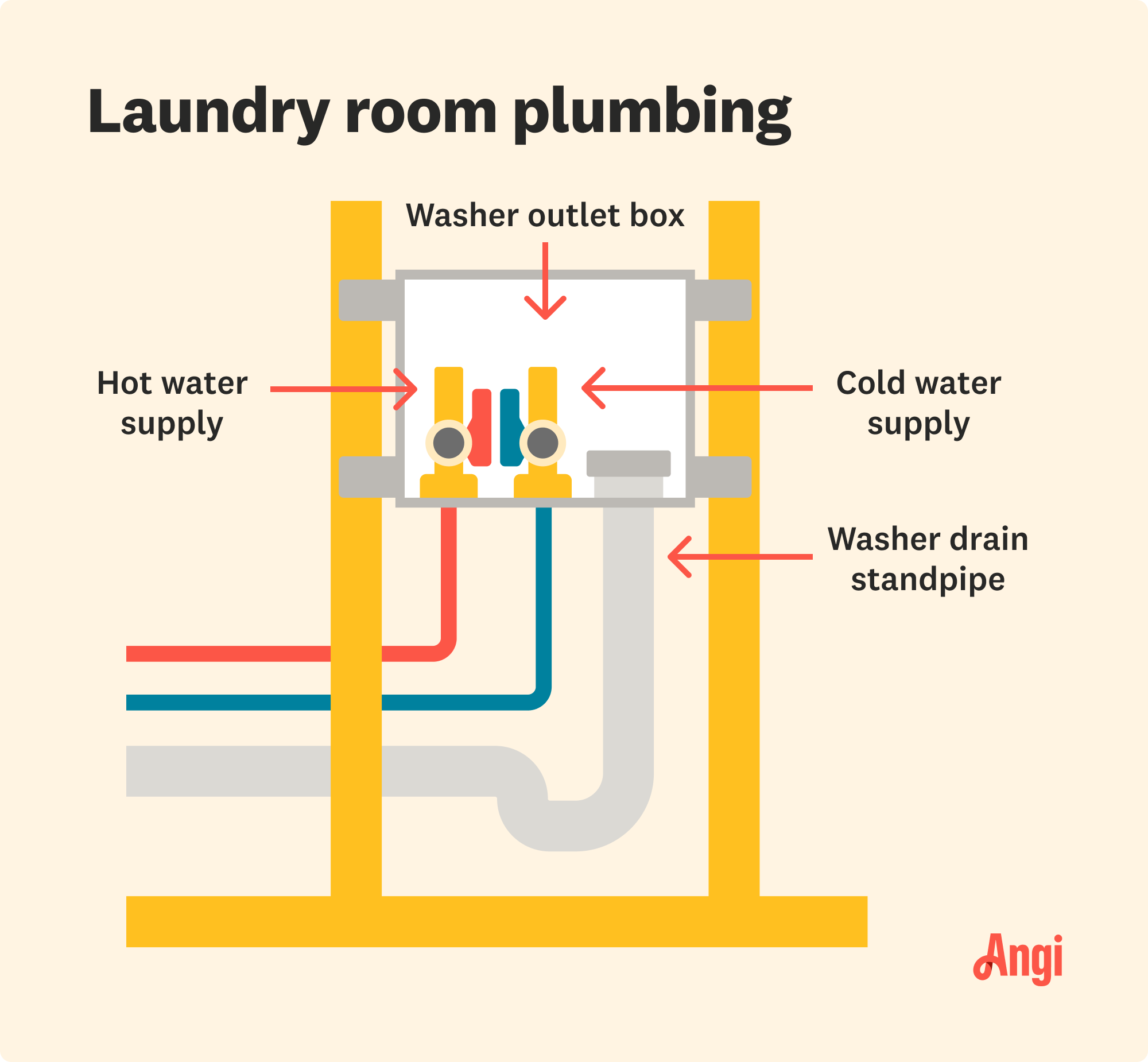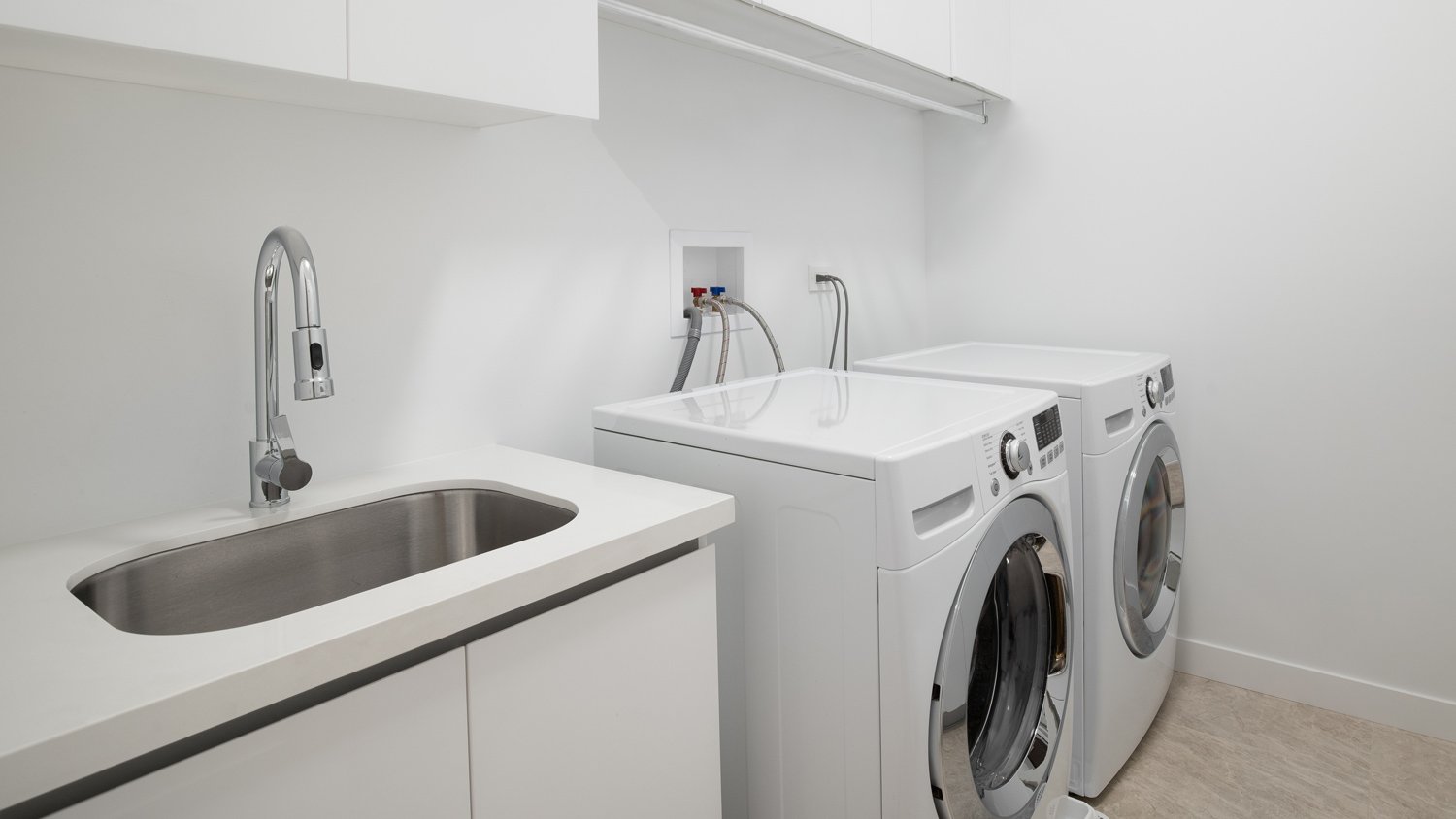Laundry Room Plumbing Code: What You Need to Know
Know the laundry room plumbing code to ensure a squeaky clean inspection


Plumbing codes govern the water supply and drainage for a building.
Local plumbing codes may vary depending on circumstances.
A washing machine drain hose should be two inches in diameter.
Water supply lines must be at least a half-inch in diameter.
Establishing a laundry room may seem as simple as setting up a washing machine and a dryer before deciding on your favorite brand of fabric softener. There are, however, plumbing codes that govern the size and location of pipes, vents, and drains for these machines. You will need to understand the particulars of these codes if you want to pass an inspection.
What Are Plumbing Codes?
Plumbing codes are regulations that provide minimum requirements for the safe design, installation, use, and repair of appliances and fixtures that operate with a water supply in residential and commercial buildings. Those appliances include toilets, sinks, and washing machines, as well as their drainage systems.
Many provisions of these codes can vary by locality; however, the installation of laundry room fixtures mainly falls under the Universal Plumbing Code (UPC) or the National Standard Plumbing Code (NSPC). Because no two laundry rooms are designed the same, compliance with a plumbing code involves familiarity with its various sections and how they apply to your space.
Local Plumbing Regulations May Vary
While the UPC and NSPC cover a wide range of the minimum requirements for water supplies and drainage in buildings, there may be individual codes that your county, city, or state follows specifically.
If a section of your local plumbing code differs from or supersedes the UPC, you should be fully aware of the differences to avoid running into a roadblock with plumbing inspections. You can find the local code by searching on the website of the appropriate government or regulatory commission for your area. You can also request the information from your building inspector.
Plumbing Code for Draining a Washing Machine

The water your washing machine uses has to go somewhere once the load of laundry has finished the wash cycle. Washing machine drain codes dictate how that water drains and where it ends up.
Washing machines feature a drain outlet to attach a flexible hose. This hose must then run upwards to fit over the edges of a vertical pipe called a standpipe. According to the UPC, both the hose and the standpipe must have a diameter of at least two inches, and the top of the standpipe must be higher than the flood rim of the washing machine.
Plumbing codes require that any water passing through a standpipe also go through a P-trap, which is a P-shaped section of pipe designed to prevent noxious sewer gases from backing up into your laundry room. The P-trap should be 18 to 30 inches below the top of the standpipe, and the top of the water level inside the drain arm of the P-trap must be six to 18 inches from the floor.
Finally, the P-trap connects to a drain line that runs vertically to a feeder line or directly to your building’s drainage network. The minimum diameter of the drain line is two inches, but the size of the drain line can vary based on individual building codes.
Codes for Floor Drains
Having a floor drain in a laundry room can be a good idea. In any area where you are dealing with a water supply, overflow will always be a possibility. If your laundry room is on the ground floor or in the basement of your home, directly connecting it to the building’s drainage system is easier than mopping up large spills.
If you intend to have a floor drain in the laundry room, the pipe attached to it must be at least two inches in diameter to dispose effectively of excess water. The opening to the drain must be covered by a strainer to minimize clogging or debris getting into your sewage system. To facilitate proper draining without leaving standing water, the floor needs to slope toward the drain at a minimum of one quarter-inch per foot.
If your floor drain has a vented trap that connects directly to the sewer and it does not empty into a sump pump, you could attach your washing machine’s outlet to it. It is not necessary to do so, nor are there any codes dictating that you need to drain your machine through the floor. But it could be handy in cases where you do not want to open a wall to install a new washing machine.
Laundry Room Water Supply

A washing machine needs water to function, of course. There are fewer plumbing codes governing the water supply to your laundry room, and many of them are closer to guidelines than regulations; however, you should still be familiar with these provisions.
Supply lines that bring hot and cold water must be at least a half-inch in diameter. These water branch lines tend to be made from rigid copper pipes, but PVC or PEX tubing is also acceptable. The washing machine connects to these supply lines via a flexible hose, typically made from braided steel, to allow movement while the machine is running.
Installing a Sink in the Laundry Room
Not every laundry room needs to include a sink, but it can be handy for hand washing delicate clothing or prewashing heavily soiled items before sending them through a laundry cycle.
There are not many requirements for laundry room sinks due to them being used mainly for utility purposes. According to the National Standard Plumbing Code, a laundry sink should be at least 12 inches deep with a strainer over the drain. The drain outlet connection for the sink should be at least 1.5 inches in diameter.
Turn to Professionals When Necessary
There are a variety of plumbing codes to keep in mind, along with provisions, updates, exceptions, and areas. If you believe that your laundry room may not be up to code, or if you would like plumbing tips to help maintain your washing machine, contact a plumbing pro near you for more information.





- Gas Plumbers
- Plumbing Repairs
- Sump Pump Installation
- Wood & Pellet Stove Repair
- Shower Repair
- Wood Stove Services
- Emergency Plumbers
- Fire Sprinkler Contractors
- Perc Test Companies
- Toilet Repair & Installation
- Boiler Repair
- Sewer Line Repair
- Faucet Repair
- Main Drain Camera Companies
- Foundation Drain Installation
- French Drains
- Bathtub Replacement
- Subcontractors
- Storm Drain Contractors
- Affordable Plumbing
- Plumbing & Heating Companies
- Bathroom Repair Services
- Sink Installation
- Commercial Plumber
- Barndominium Builders
- Water Line Repair
- Faucet Installation
- Water Line Installation
- Leak Detection
- What to Know About Washing Machine Drain Code Requirements
- How to Fix Frozen Washing Machine Pipes
- How to Clean Your Laundry Room: An Easy Laundry Room Cleaning Checklist
- How to Install a Kitchen Sink Drain in 10 Simple Steps
- What to Do About Hard Water in Your Washing Machine
- How Long Do Washing Machines Last? Here’s the Average Lifespan
- 10 Most Common Plumbing Problems Every Homeowner Should Know
- Here Are All the Parts of a Washing Machine—and What Each One Does
- How to Vent a Toilet, Sink, and Shower
- 11 Tips for Maintaining a Front-Load Washing Machine










